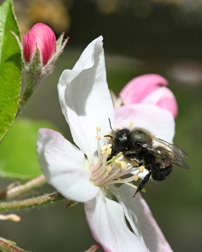This page has been archived and is being provided for reference purposes only. The page is no longer being updated, and therefore, links on the page may be invalid.
|
|
Creating Homes that Please America's Wild Bees
By Marcia WoodApril 4, 2008
Just like people who are looking for a perfect place to live, some female bees search for the ideal place to build their nests.
Agricultural Research Service (ARS) entomologist Theresa L. Pitts-Singer is discovering more about the "nesting cues" that influence wild bees' house-hunting decisions. It's information that may help entice more of the hardworking pollinators to take up residence in new, ready-to-occupy nesting structures that growers and beekeepers provide.
Some bees like living in snug, dark recesses called "nesting cavities." These range from deep holes drilled into wooden boards, to bundles of cardboard tubes or hollow reeds. Growers and beekeepers place bee housing in orchards and fields where they need the bees to live and work.
Wild bees augment the work of the European honey bee, currently plagued by a puzzling problem known as colony collapse disorder. That's according to Pitts-Singer, with the ARS Pollinating Insect Biology, Management and Systematics Research Unit in Logan, Utah.
Scientists already know that female blue orchard bees (Osmia lignaria) and certain other wild bees prefer to nest in cavities that other females of their species once occupied. That's problematical because old nests may be contaminated with disease-causing spores.
To find out what's making old nests alluring, Pitts-Singer is investigating components from the old homes, including old pollen, leaves, mud, and a fluid bees apply to cavity walls.
In one test, Pitts-Singer and colleagues used glass tubes to approximate drilled nesting holes, then collected the now-dry fluid that bees had left on walls. The scientists are using sophisticated laboratory instruments to glean some of the first-ever information about the chemical composition of the fluid.
Perhaps secreted by bees to differentiate one home from another, the fluid may also add to the overall appeal of a previously occupied nesting site. If that's the case, Pitts-Singer's investigations might lead to using synthetic versions of the fluid to make tomorrow's new nesting structures more inviting.
ARS is the U.S. Department of Agriculture's chief scientific research agency.

